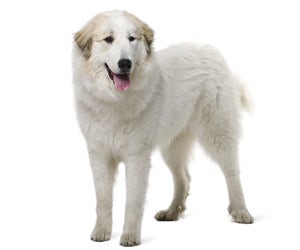Great Pyrenees
-
Overview
The Grand Pyrenees is a noble, powerful breed from the mountains of France. These giant dogs, who generally weigh over 100 pounds and stand up to 30 inches tall, are effective guard dogs who bond loyally to their owners and expect the trust to be returned. These dogs make devoted, protective companions for owners who have plenty of time to teach their huge dog polite manners. They need to be exercised and socialized, but they also need to be taken seriously by their owners. They are serious guard dogs who expect to trust and be trusted. Once they've bonded to their family, they are diligent, affectionate companions.
-
Personality
Great Pyrenees are generally well-mannered and gentle, but they are more than willing to protect their family when needed. If they sense distress, they won't hesitate to bark, which makes them excellent guard dogs. They are big and imposing, and they know it. Pyrs aren't afraid to use their size and their bark to defend their owners and their property. In fact, if you're hoping your big guard dog will warm up to your friends and neighbors, you'll have to have them introduced. As instinctual flock guards, Pyrs will need to be socialized consistently to learn to effectively determine friend from foe. With socialization and rewards for polite behavior, the Great Pyrenees can be a very effective guard dog and a sensitive, friendly companion.
Pyrs are affectionate dogs. They love to feel close to their and they demonstrate their love to their people by pawing, nudging and licking them. Pyrs love to snuggle and make their owner's space their space. Don't expect your dog to realize that his size prevents him from joining you in bed or on the couch. These giant dogs are also independent. Their size and strength enabled them to work on their own, guarding flocks and hauling supplies through the Great Pyrenees mountains. As a result, they've been bred to make their own decisions, and they might require extra patience and firm, dominant commands to reach their full potential.
-
Coat Care
The Great Pyrenees's coat is only seen in white. Some dogs have cream or tannish markings on their body and ears, but the coat should be predominantly white. The abundant double coat makes the dog appear more substantial than he actually is. The coat is weather-resistant with a very thick, wooly undercoat and a soft, long and straight overcoat that stands out from the body. All dogs, but especially males, have a noticeable neck ruff and a long-haired, plumed tail. The coat acts as insulation in hot and cold weather, so don't feel the need to clip your Pyr short in the summer.

They will require frequent brushing with a slicker brush and a metal comb to remove dead hairs and keep the coat looking shiny and healthy. Twice a year, when the Pyr sheds, he will need to be brushed even more frequently to prevent matting and tangling of dead hair in the coat.
These dogs also need to be bathed, which can be a challenge if you don't help your large dog become accustomed to bath time as a puppy.
Generally the Great Pyrenees' eyebrows, whiskers, ears, hocks, feet, and forelegs are trimmed, although that's usually for dogs showing in conformation. Working dogs or dogs who live in areas with lots of room to run will need to have the hair around the pads of their feet trimmed frequently, because this hair picks up burs and can mat painfully between the dog's toes.
Pyrs have double declaws on the backs of their legs which help them climb up and down tough terrain in their mountainous homelands. These should not be removed because they give the Pyr their powerful, bounding gait.
Their floppy ears need to be washed out and checked for infection.
Many owners do not realize how important it is to brush your pet’s teeth on a regular basis. Some dogs are prone to dental problems and sensitive teeth, especially small dogs with tiny teeth and dogs with special diets. These problems can be easily combatted with frequent brushing.
Cavities are rare with dogs but gum disease caused by tartar buildup is not, which is why they require regular brushing with toothpaste and a toothbrush formulated specifically for dogs. While daily brushing is ideal, doing so on a weekly basis will be a big help in avoiding the need to bring your dog to a veterinarian for a cleaning, which usually has to be done under sedation.

 India (English)
India (English)
 Middle East and Africa (English)
Middle East and Africa (English)
 South Africa (English)
South Africa (English)
 Australia (English)
Australia (English)
 Japan (日本語)
Japan (日本語)
 South East Asia (English)
South East Asia (English)
 Singapore (English)
Singapore (English)
 Europe (English)
Europe (English)
 United Kingdom (English)
United Kingdom (English)
 Argentina (Español)
Argentina (Español)
 Brazil (Portuguese)
Brazil (Portuguese)
 Colombia (Español)
Colombia (Español)
 Latin America (Español)
Latin America (Español)
 México (Español)
México (Español)
 Chile (Español)
Chile (Español)
 Peru (Español)
Peru (Español)
 Canada (English)
Canada (English)

